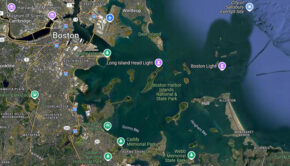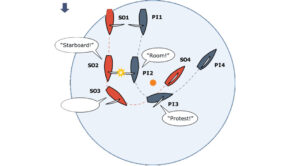Ask Kids What They Want
Published on March 17th, 2019
At the 2019 National Sailing Program Symposium (NSPS), youth sailors Will Levy, Mallory Edwards, and Sydney Monahan, ages 16, 17, and 18 respectively, led the panel discussion titled “Ask Kids What They Want” in Jacksonville, Florida.
With a room full of sailing leaders, this was an opportunity for attendees to hear a non-adult perspective on the sport. The session started out like any other, but the dynamic quickly as the panelists inspired the audience.
It’s not hard to grasp why this youth panel was so engaging and refreshing. Youth sailing, as well as other youth sports, is organized by adults, and yet, the number one rule of business is: know your customer.
That’s why the top recommendation of Aspen Institute’s Project Play initiative is to “Ask Kids What They Want”. In order for our sport to adapt and grow, we need to understand what young participants and leaders want out of their sport experience and empower them to help shape the future of the sport.
Sydney, Mallory, and Will each contributed great insights and stories from their own sailing experiences as well as a fresh perspective on how to get more kids into sailing. Here are a few of the highlights:
Engagement is more important than equipment
When the panelists were asked about different classes of boats, they didn’t have strong preferences. But, they all agreed that learning from attentive and engaging instructors, coaches, and mentors makes a big difference in a youth sailor’s experience.
Mallory described that “when I was really little, I had a sailing camp coach who I really looked up to, who was really great and really fun. She helped me stay with it.” However, she added that engagement beyond the beginner sailing level is equally important.
“I definitely think that between the coaches in soccer and coaches in sailing, sailors get a lot less attention from a sailing coach than they would from a soccer coach. So I think that a big thing for sailing coaches is to give kids more attention.”
Sydney added that “Anyone can talk about soccer, or football, or tennis. But talking to non-sailors about sailing can be very frustrating sometimes. So that’s a big difference for people who grow up with parents who sail, because they have that support at home. If their coach isn’t helping them, their parents know what the next step in their pathway is.
“And while in soccer it’s pretty obvious what the next step is, in sailing there are so many options that it is hard to choose. So if you can’t spend money on more instructors, at least help sailors find what their next step is, and what direction they want to take it, to keep them in the sport.”
It’s the social part of sailing that keep kids coming back
Mallory “I don’t know about other kids, but I don’t like to be alone. I like to talk to people, I’m a people person. I definitely would encourage starting kids out with doublehanded or group sailing, so they have someone there to support them, and then moving to singlehanded or other types of boats.”
Sydney added that her program shakes things up by sailing big boats on long distance trips. “We’ve done a couple of overnight trips, and that was really fun, and brought the older kids and younger kids together for fun sailing, rather than racing.”
Will pointed out the importance of building a team identity with branded team gear. “I’d say it’s very important to get gear, because then you feel like part of a team. At my school it was a lot of work to push for sailing to be recognized as a team sport.” Mallory added “we got our new pinnies last year, and they are so nice. When I put it on, I feel like a real sailor.”
Reverse roles with adults
Mallory shared a creative way to get kids and adults to see sailing from a new perspective. “We called it the flip flop regatta, where the kids ran the races and the adults sailed the kid boats. My dad sailed with my friend’s dad in a 420, and it was a lot of fun for the kids to experience another part of the racing, being in charge of the race committee and the on shore planning of the regatta.”
Teenagers feel pressure to manage their time
Will suggested that one way to help encourage new sailors to try the sport is to offer flexible programs that don’t require much time. “I would suggest programs with less commitments. If a kid is doing other sports they might only have one day off during the week, and offering a once a week lesson, or a flexible program so that kids can enjoy the sport but fit it into their schedule.”
Sydney added “I agree with Will. Time is our biggest factor in high school. So making it more flexible would help get new people into sailing.”
Over one hundred people attended the “Ask Kids What They Want” panel at NSPS and, at one point, nearly half of the hands in the room were raised with questions. The value in listening to feedback and ideas from kids is clear, and stakeholders such as sailing clubs, program directors, coaches, and parents can all help by creating opportunities to actively listen to youth participants.
Many clubs have a Junior Board with positions for youth representatives, which is a great way to give kids a clear role in the decision making process. Project Play also recommends conducting participant surveys and re-evaluating the metrics used to measure program success:
“Survey kids to capture their feedback, and share data with coaches and the sport board so they can adjust policies and practices…. evaluate program success based on factors such as fun, diversity, participation and retention rates, and the development of skills that foster physical literacy. Wins and losses shouldn’t be the prevailing metric.” More recommendations are available on the Project Play website.
US Sailing is featuring “Ask Kids What They Want” sessions at this spring’s Regional Symposiums in New York, California, Rhode Island, and Maryland. Visit the US Sailing Regional Symposium website for dates and locations.
Source: John Pearce and Ariana Smaldone








 We’ll keep your information safe.
We’ll keep your information safe.